Our Travel Report Zimbabwe and Botswana aims to support you in finding the best lodges and the most convenient itinerary for your 15 days trip. This was a “flying” safari.
1.Day: Munich -> Paris -> Zurich -> Johannesburg
2.Day: Johannesburg -> Victoria Falls (Batonka Guest Lodge – Zimbabwe)
3.Day: Victoria Falls
4.Day: Victoria Falls -> Kasane (Kubu Lodge Kasane – Botswana)
5.Day: Kasane -> Zambezi Queen – Namibia
6.Day: Zambezi Queen
7.Day: Zambezi Queen -> Ghoha Hills (Ghoha Hills Savuti – Botswana)
8.-9.Day: Ghoha Hills
10.Day: Ghoha Hills -> Camp Okavango
11.Day: Camp Okavango
12.Day: Camp Okavango -> Sango Safari Camp
13.-14.Day: Sango Safari Camp
15.Day: Sango Safari Camp -> Maun -> Johannesburg -> Zurich -> Paris -> Munich
Travel was organized by: African Special Tours
Local currencies: Zimbabwe: “Zimbabwe dollars”, but US dollars are widely accepted and expected. If possible, take small USD bills for tip, which is also expected in USD. Botswana: Botswana Pula, but again USD is welcome in the lodges. Otherwise, credit card payment works everywhere.
Vaccinations: Coming from Germany no vaccinations needed – even no yellow fever. However, the standard vaccinations are recommended, see suggestions Foreign Office.
Luggage: When traveling in Africa by light aircraft, you should pay attention to “soft” luggage (such as sports bags) and the weight limit. The photo equipment should definitely be taken on board, so pay attention to cabin luggage (!)
Helpful: A small pocket knife and a strong flashlight with spare batteries are often very useful. The cell phone flashlight does it too hard, but often does not shine far enough.
Visa: From Germany (German citizens) you need a visa for all countries, but those can be bought at arrival, at the airport or border station.
Clothing: Since it is “winter” in the countries visited in May, you should be prepared especially for the evening and at night, as well as the early morning for cold temperatures that can even go to the freezing point. In the lodges in Africa you can usually wash your clothes for free or for a small additional charge.
Day 1: From Munich via Paris, Zurich, Johannesburg to Victoria Falls (VFA).
The journey starts with a first small disaster. Unfortunately our luggage has not made the first flight to Zurich. The Swiss on-board staff is great and provides us with cotton pyjamas, which in Africa may actually work as day wear. Fortunately, we have not checked in the photo equipment.
Day 2: On the approach to Victoria Falls you can see the Victoria Falls already with up to 500m high rising spray.
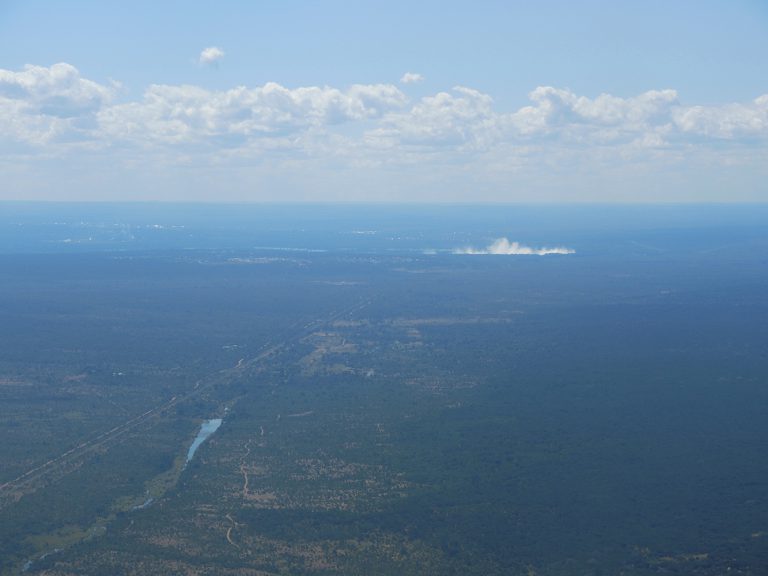
Landing in VFA. It does not feel like you’re at an international airport. But at least South African operates the 1: 20h flight with an A340 (!)
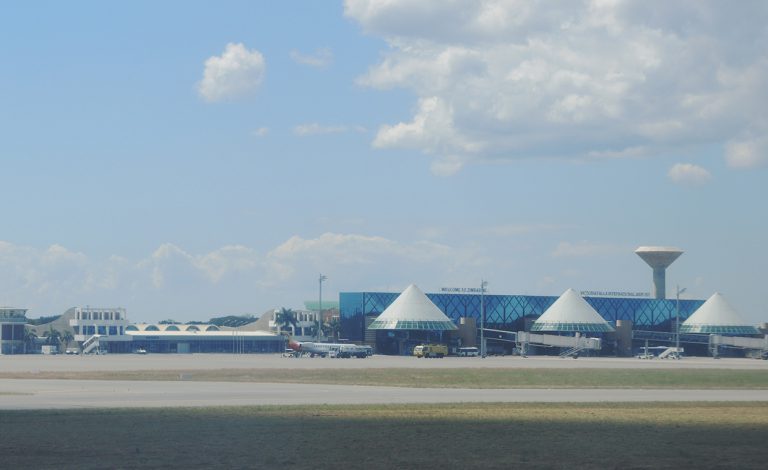
The entry takes a felt eternity. We had only 10 people in front of us, but the visa officer needed a good 5 min per person. Too bad for the 240 people behind us.
The Kaza visa for Zimbabwe and Zambia is the same price as the Zimbabwe visa, so worth to go for it (about 50USD). After immigrations we went to the lost and found counter. 10 minutes later we already had the first e-mail with all the luggage tracking data. At the exit stood our driver with name tag and off we went to the first accommodation.
Batonka Guest Lodge. Hard to guess from the outside, a little paradise.
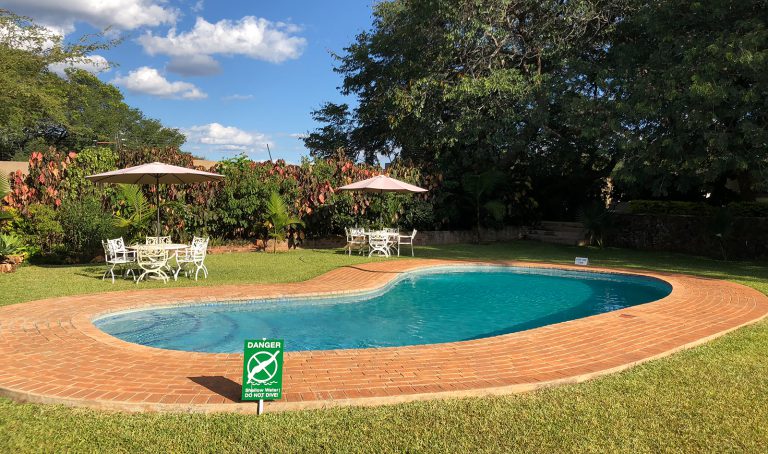
Recommended by the Batonka staff we took a taxi to the Safari Lodge at about 5 pm. The taxi prices are moderate but you should agree on the price before.
The Safari Lodge offers spectacular sunset views.
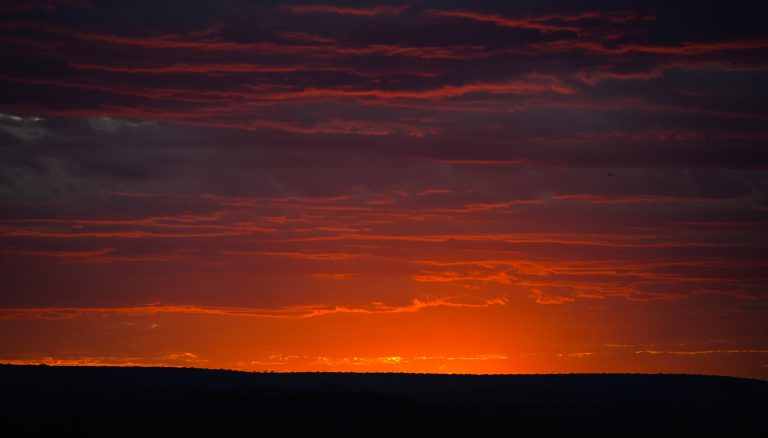
Photographically, you should have a telelens, preferably 70-200mm. If nothing else is on hand your phone camera will do it too, but less good of course. Two Zambezi beer later (actually brewed in Victoria Falls) we returned to the hotel having experienced a fantastic sunset.
Day 3: We walk to the waterfalls. After about 1h with various stops in the souvenir shops to buy caps and T-shirts (both because of missing luggage), we reached Victoria Falls Entrance and 60 USD we were already poorer.
For another 6 bucks we borrow rain ponchos and after 2 cheese sandwich and 2 coke for 18 USD we start the tour (nobody said Zimbabwe would be cheap).
From Lookout 1 to 6 we only get a bit of spray. After that, it’s more like a cloudburst.The Zambezi floods and about 500mio liters of water per minute thunder down. Spectacular!
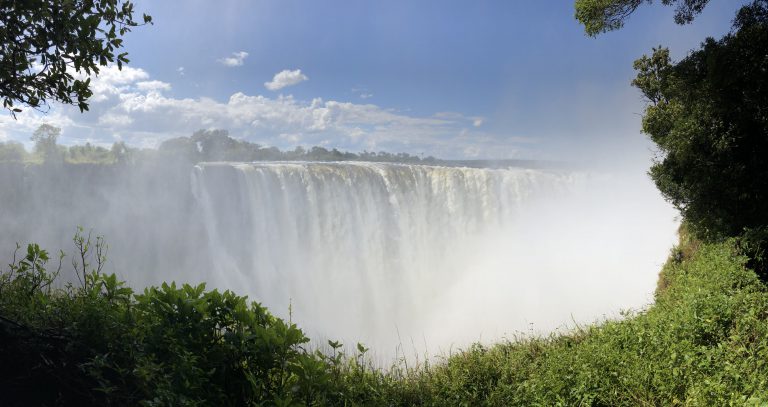
After about 2.5 hours we go back and walk to the Victoria Falls Hotel. Here time seems to have stopped in the last century. We enjoy the high tea for about 30USD. Highly recommended and a great place to get down and relax.
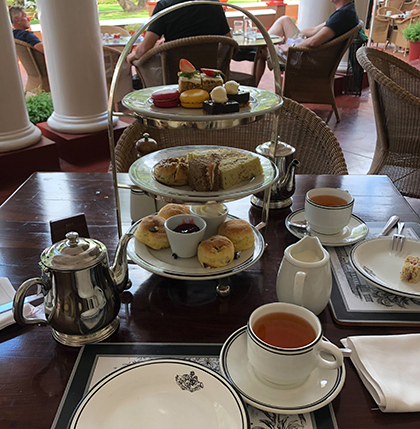
Afterwards we walk back to the lodge. Altogether we saw elephants, baboons and monkeys as well as a mongoose family while walking.
Elephants – wild – so close to a city we have never seen before (during the day and on foot). Incidentally, Victoria Falls can be explored very well on foot and is generally considered safe for tourists. As always, caution is required abroad. We had no problems and everyone was helpful and nice.
Back at the guesthouse, we are told joyfully that our luggage has arrived.
Day 4: We wake up early and decide to go to the Lookout Café. The fresh elephant dung along the way shows that we are not alone. Nevertheless we do not do any sighting.
When you arrive at the café, you feel like you are standing at the entrance to paradise. We have never seen such a majestic view before. The Zambezi floods and the rock walls are golden yellow bathed in the rising sunlight. No one else is there except us and the staff. We order 2 coffees and enjoy the view.
The Lookout Cafe: An absolute must for any photo enthusiast and definitely a “must see” when visiting the Victoria Falls. Tip: At full moon in the evening go there (make reservations!), Because then the moon rises over the gorge.
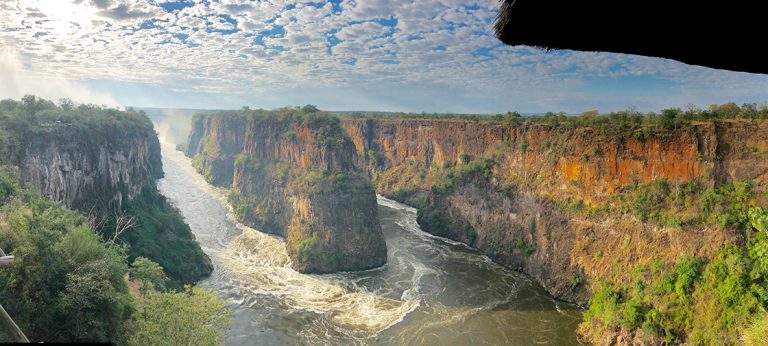
For the way back we use the free shuttle. We are picked up punctually at 11:30am and taken by bus via the border station Kazangula to Botswana.
The entry is as always an adventure with many stamps and nonsensical rules (everyone has to step on an old mat with disinfection to clean the soles of the shoes, which are much dirtier afterwards than before). At about 1pm we reach the Kubu Lodge. A 30-acre area, right on the Chobe River.
The garden is a dream, the lodge rather not. For the price clearly not worth it.
If you have the necessary money, you should stay at Chobe Lodge.
At 3pm we have the first sighting of a black mamba and the realization that some people simply should not go on safari.
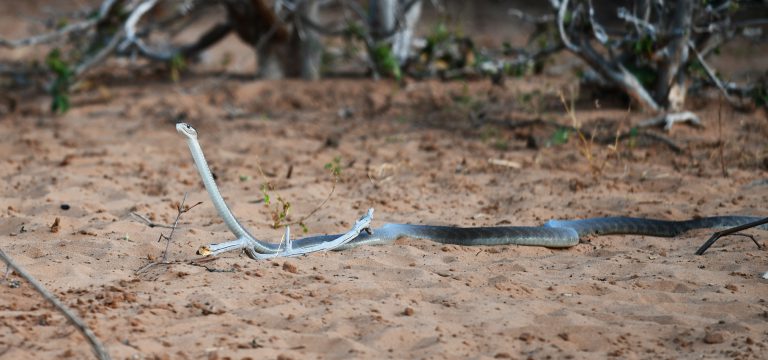
A woman who told us previously that she has balance problems, wanted to photograph a lioness, which 10m away from our car passed by.
Suddenly there was a “BANG” and then the lady was already lying next to the jeep. Fortunately, on the side facing away from the lioness, so that the lioness just continued after a short stop.
Stay in the car, unless the guide allows getting up and definitely not “hanging out” or trying to climb the car.
Day 5: At 12:30 we are picked up and driven to Kasane, where we reach the adventurous border from Botswana to Namibia. Here we are already expected by an employee of the Zambezi Queen. Somehow we had imagined the border station at the river in a different way, but it also works like this.
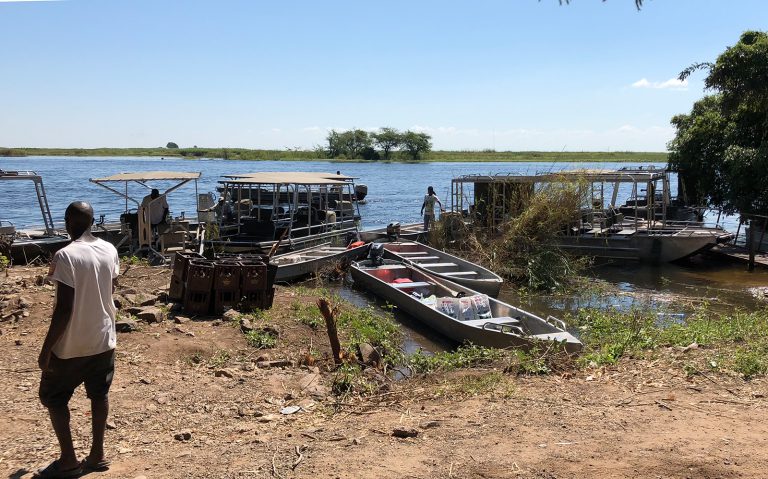
After about 20 minutes by tender boat we reach the Namibian border station on the other side of the river. Again, adventurous and the official wearing sunglasses is even cooler than a bucket of ice cubes. You do not want to have a problem here.
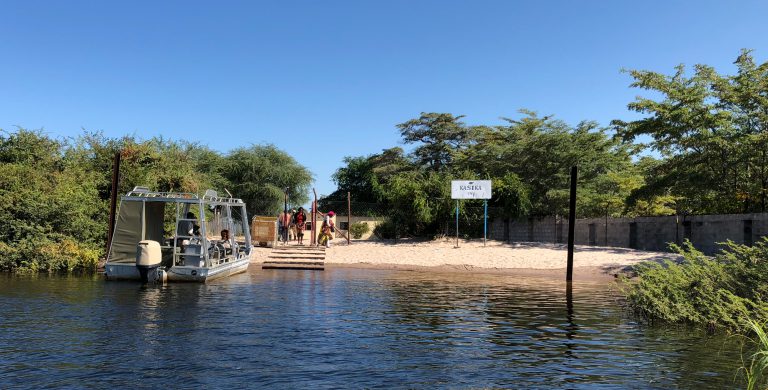
Back on the tender boat we drive about 10 minutes, then we see the Zambezi Queen already majestically in the river. A 5 star ship without question.
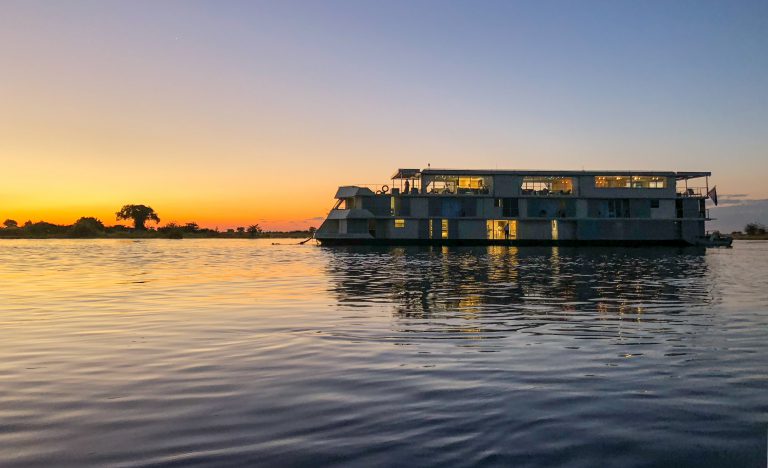
After a safety briefing lunch is served, then we rest and unpack and at 4 pm we go on the first boat safari. Dreamlike speedboat ride over the Chobe River. The sunset on the water is spectacular.
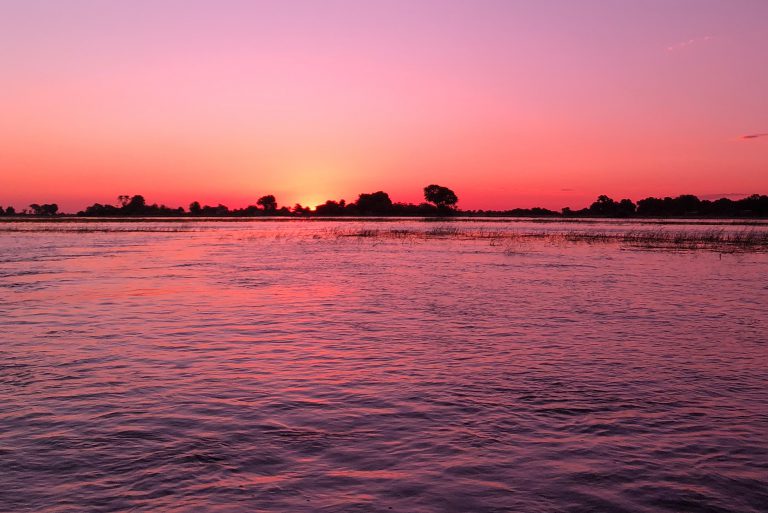
Day 6: At sunrise, we go on deck for a first coffee. Another dream day. At 7:00 clock starts the Birding Tour. We are only two. The birdlife on the river is incredible. Particularly fascinating are the ospreys, of which there are plenty and the Kingfisher in all variants.
Definitely join the birding tour. Many guests still want to sleep at the time and you are traveling in a small group. The photo opportunities are numerous and the light is priceless beautiful.
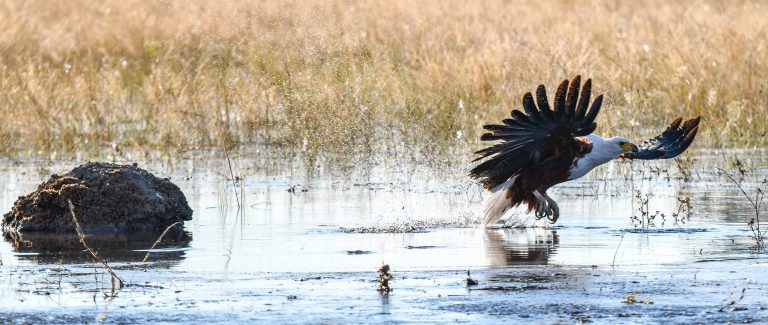
Back on board and we have breakfast and enjoy the short trip to the next landing station. What we find a bit disappointing is, that the ship is not – as expected – the whole day cruising up the river, but only about 10 km and then moored to a mole again.
The view from the new anchorage is again spectacular. In the afternoon we continue with a water safari in a speedboat.
A small tip: you should never aim the mosquito spray on the smoke detector, unless you want to get to know the captain in underwear in the evening at 10pm.
Day 7: As usual on cruise ships, the luggage is picked up at 9am. Then it’s time for the tender boat and it’s time to say goodbye to the Zambezi Queen. Same procedure as 2 days ago, only this time in reverse order.
From customs we are taken directly to the airport of Kasane. The journey takes just under 10 minutes.
A member of staff from Mack Air welcomes us and takes over the check-in of the two bags. Mass? Nobody asks. Sizes? Do not care.
We were a total of 10 people boarding a single-engine Cesna 208 with a pilot from New Zealand.
The start is fast and with a left turn over Kasane we fly to Chobe Lodge. After a good 65 minutes in total, we land on our airstrip.
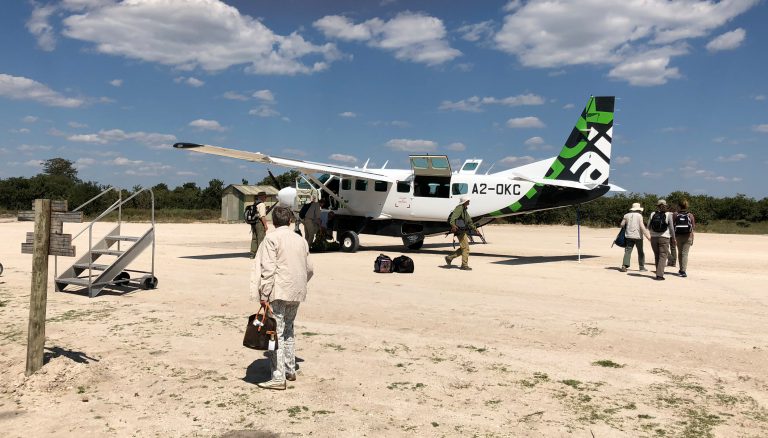
A staff member from Ghoha Hills welcomes us with cool, damp towels and fruit pies, then we head to the lodge. Again about 45min ride. The lodge is really nice.
After a light lunch, we rest a little in the comfortable armchairs. At 4pm high tea and 4:30 am the first mini safari to the Sundowner starts.
Day 8: Since my wife was struck by a severe gastrointestinal infection during the night, we stay at the lodge all day. Only in the afternoon does she feel better. The Sundowner Game Drive goes this time to the “Hide” of the lodge, at a small, idyllic lake.
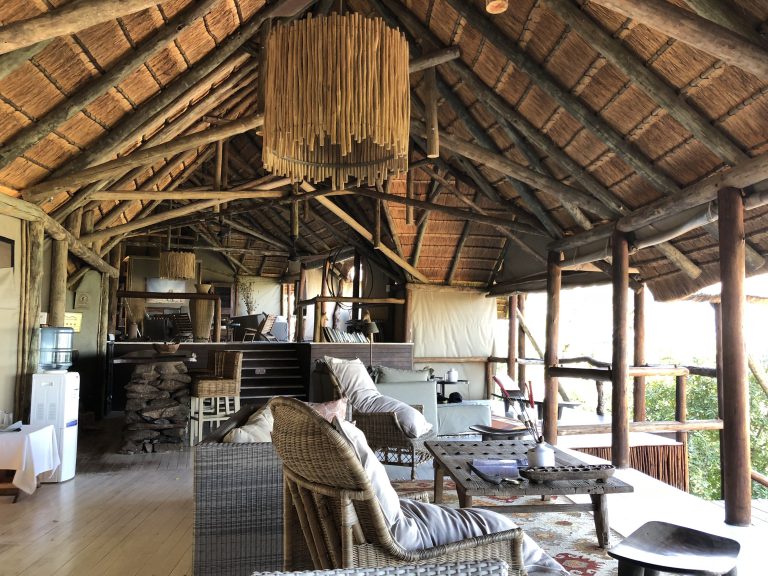
Day 9: We have the safari car all to ourselves. At 06:30am we get going. After a good hour’s drive, we arrived in the Savute area of Chobe Park and see many zebras, wildebeest, a secretary bird (highlight) and after much driving 2 Cheetahs hidden in high grass.

We get the information that 3 lions have killed a zebra and we set off. When we arrive, the zebra is already dead in a bush and we don’t see much. But the lion and a lioness come out for the “photo session”.
Then it’s lunch outdoors. Rem, our guide, sets everything up in the middle of the bush. A great experience, especially as we are surrounded by zebras and giraffes. Afterwards we drive back to the lodge, where we arrive around 14 o’clock, we are quite broken.
Tip: The difference between Ghoha Hills and other lodges is that you make a very long game drive per day (about 7-8h) and a shortened sundowner in the evening (about 1,5h). The dinner with Lean & Elmarie Marnewick, the manager couple, is very nice again and we enjoy the last evening.
Day 10: After breakfast we are driven by Edwin to the airstrip. Suddenly everything goes very fast again. Punctually at 10:30 o’clock our plane lands. Suitcase inside, board and already we are in the air. 25min later we land right next to Camp Okavango.
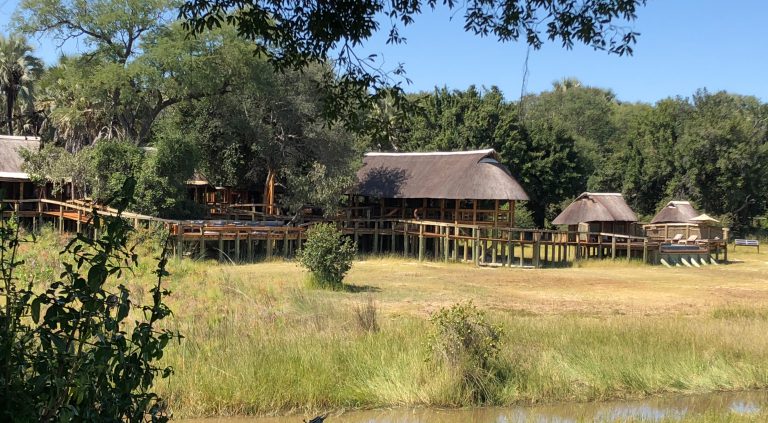
Ernie, the manager, gives us a warm welcome. The camp is newly opened in March 2016 and very well equipped, except that it is the first time that you are really “off” here, as there is neither Wifi nor telephone reception. In the afternoon we go on a boat safari with Mec, our guide.
Day 11: Walking Safari. We walk 5 km through the bush, which is good for our fitness after days of gluttony.
But everything we see (hyenas, antelopes, elephants etc.) is much too far away to photographically make anything out of it, unless you would carry a 600mm tele.
At 4 p.m. we go on a tour with the Mokoro, the dugout canoe of the locals. At first I am skeptical, but the things are comfortable and you glide silently through the delta, which helps to see shy animals. Should one have done simply times.
While one should simply leave his camera in the camp for the bush walk and enjoy the walk itself, you should definitely do a tour with your camera in the Mokoro, as it glides silently through the water and you get very close to the animals, especially birds.
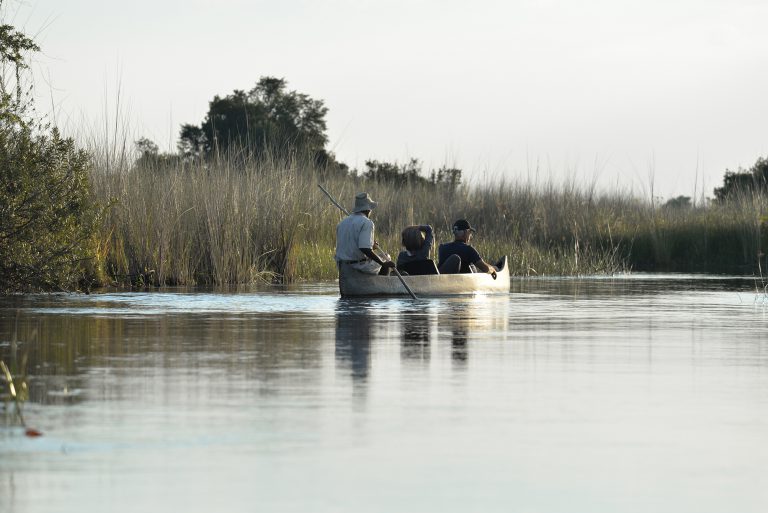
The sundowner is then at the jetty and afterwards it goes on foot to the lodge. The dinner is again very entertaining, as the staff with each food recommendation speaks a loud “Mmmmmhhhh” to itself. Funnily funny. After a last red wine under a brilliant sky, it goes to bed.
Day 12: At 06:30am we take another boat safari, this time with Karl. The tour is awesome. We see elephants, antelopes and many birds, but especially the malachite kingfisher.
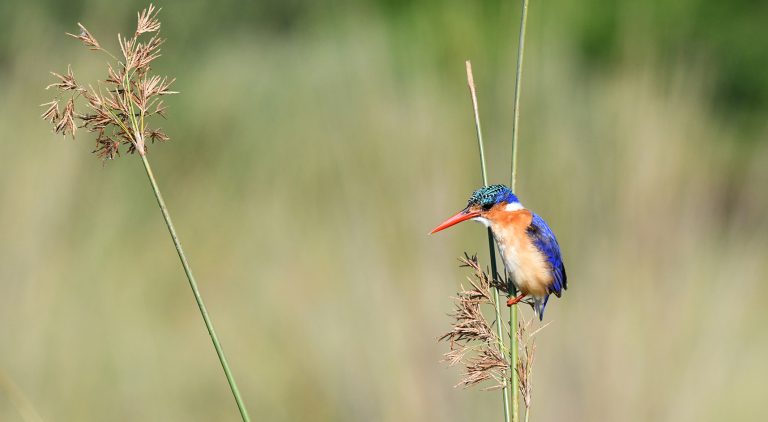
3 hours later we are back. Fast, shower, pack, have breakfast and at 11:15am we sit again in the plane. This time a young lady pilot with Rasta hairstyle. Very cool! The machine is great, too. Nice with leather chairs. Purest business class. After 20min flight we land in Khwai.
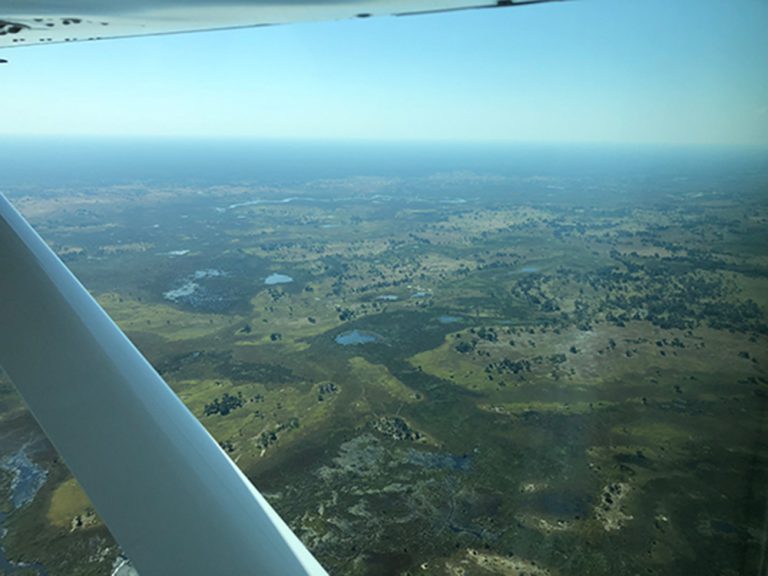
Another 25min drive later we arrive at Camp Sango.
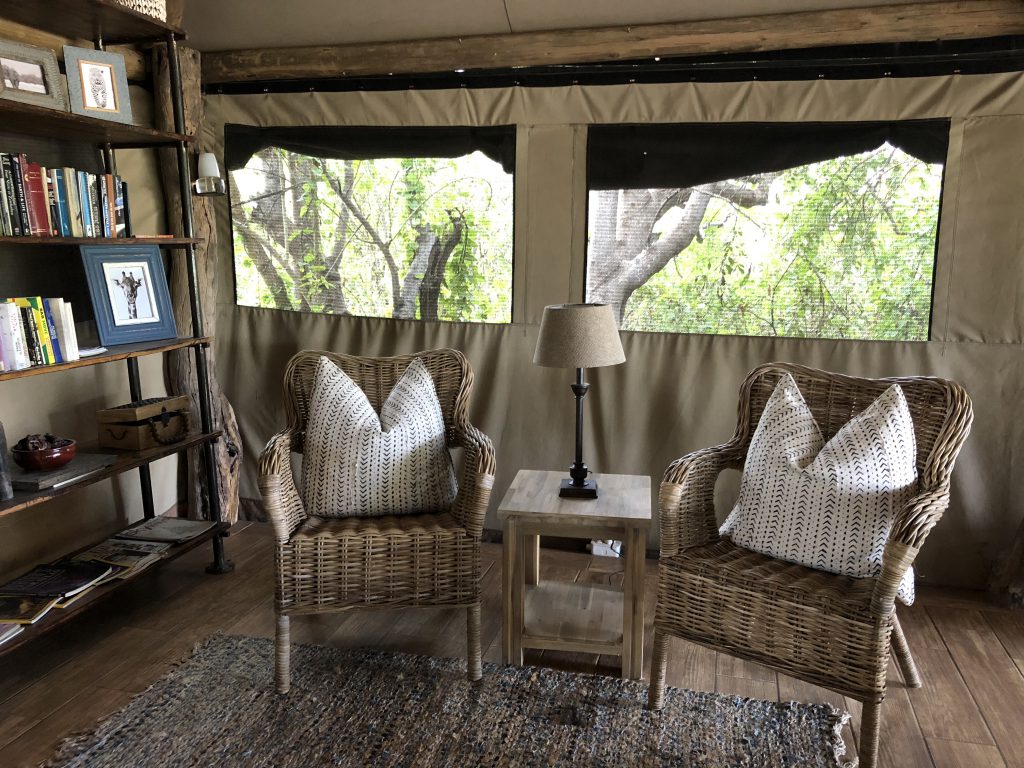
Total max. 12 guests and very familiar, not luxurious but nice. We have tent No 1and the best view. The note from Mike, one of the managers, that the tree next to our tent was “executed” by Elephant’s raises questions.
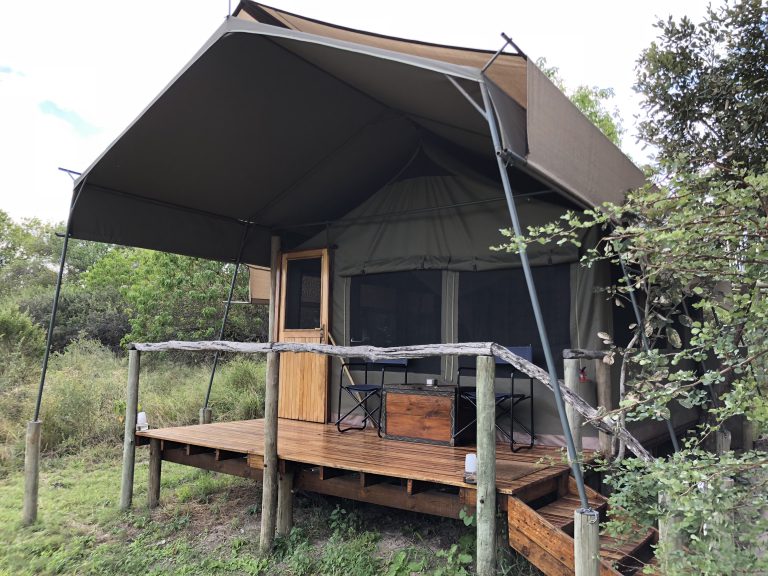
At 4 pm our first jeep safari since days starts. Our guide is “BK” a very young ranger. But with 10 years of experience.
Day 13: We wake up at 05:30am. It is much cooler than usual and getting up is difficult. Nevertheless, we manage to catch ourselves at the campfire for breakfast and at 06:30am we start the first drive of the day. Right at the beginning a spotted hyena and a short time later a leopard.
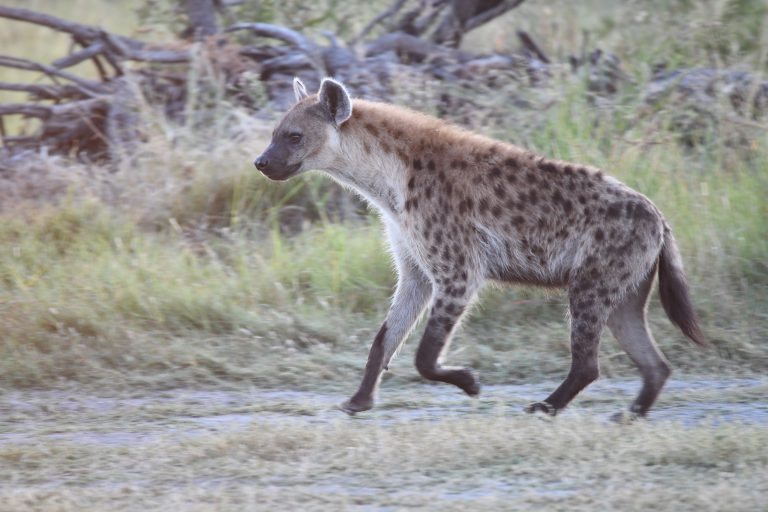
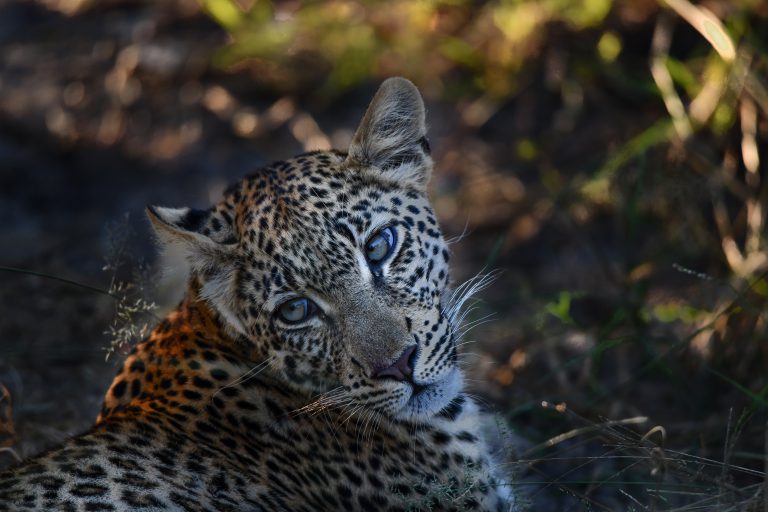
How much better can a day start? Only the lions we do not find. After a coffee at the waterhole we start the way back. The time until 3:30 (High Tea) we spend watching the numerous elephants, who eat the green grass on the riverbank directly in front of our veranda and do not let anything disturb us.
Day 14: On the morning drive we get the information that wild dogs were spotted. BK “races” through the bush. Unfortunately, I do not have my sunglasses on, when I feel a fist-sized beetle pops into my right eye. Ouch! That hurts the whole day.
After about 30 minutes we reach the Wild dogs. That’s an impressive animal. However, they are lazy and full. The blood of the last Impala still in the fur they rest on the road.
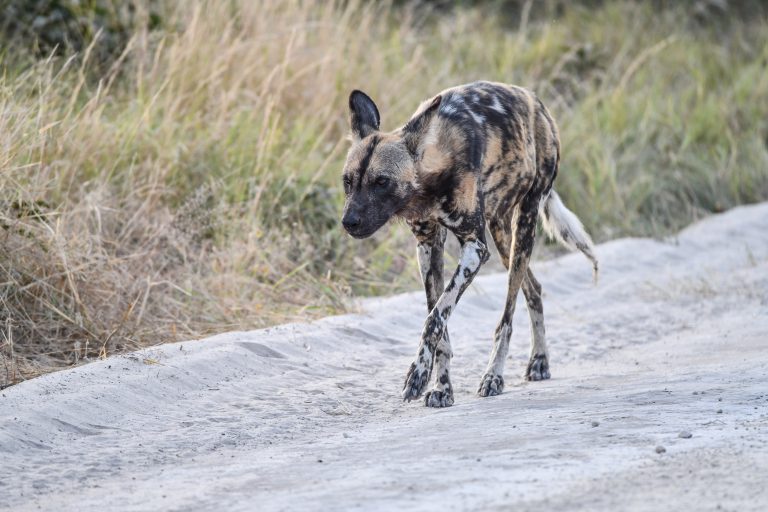
Since we are alone in the car, we afterwards go back to the lodge, see some rare antelopes and impalas.
During our afternoon game drive we get the info, that “Umkwe” (leopard on Sizzua) was discovered, with a just killed Impala. As we arrive there are already 6 other safari cars on site. It’s a bit crowded, but BK ensures us a good position. We spend a good hour, then take our sundowner and drive back to the lodge.
Day 15: One last game drive and we see one of the male lions, because this time we drive directly into the Moremi Reserve. This is really a highlight to say goodbye.
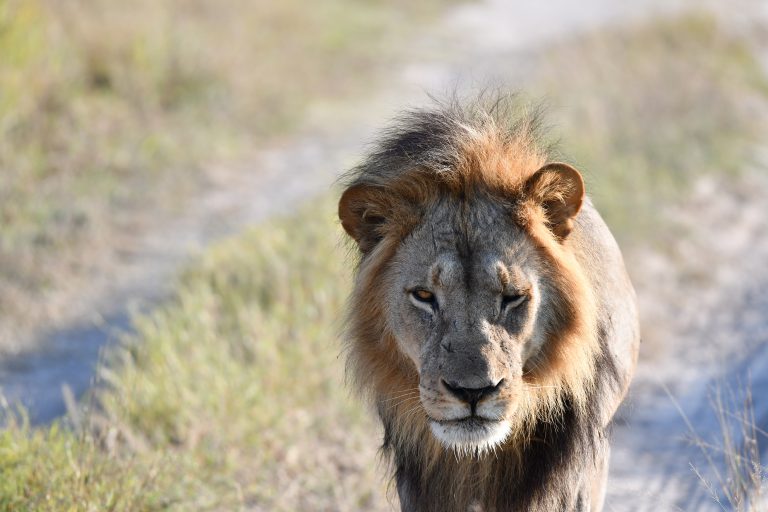
Back in the lodge it’s time to pack and leave for the airstrip to our last flight to Maun. The waiting hall for the departure to Johannesburg is a bit adventurous. In Johannesburg we have to do immigration to South Africa as normal, get our luggage and check in again for Munich. Quite awkward.
The journey was an absolute Africa dream. You can’t say more about it.
In Botswana and Zimbabwe it is advisable, for time and many other reasons, to make such a tour with the small airplane.There are hardly any petrol stations and the roads are usually extremely bad. You should be aware that most lodges are really far away from any place. Therefore always pack a good first-aid kit.
Another final tip for the photographic equipment. Long telephoto in any case, ideal are 300mm or more. In addition and actually enough a fast light zoom (for example 24-70mm or the cheaper 24-85mm from Nikon).
The photographic equipment that we brought to Australia can be found below. In addition, you have the opportunity to order the used photographic equipment directly through our photo shop and to request further technical details. There are also a lot of extras.
